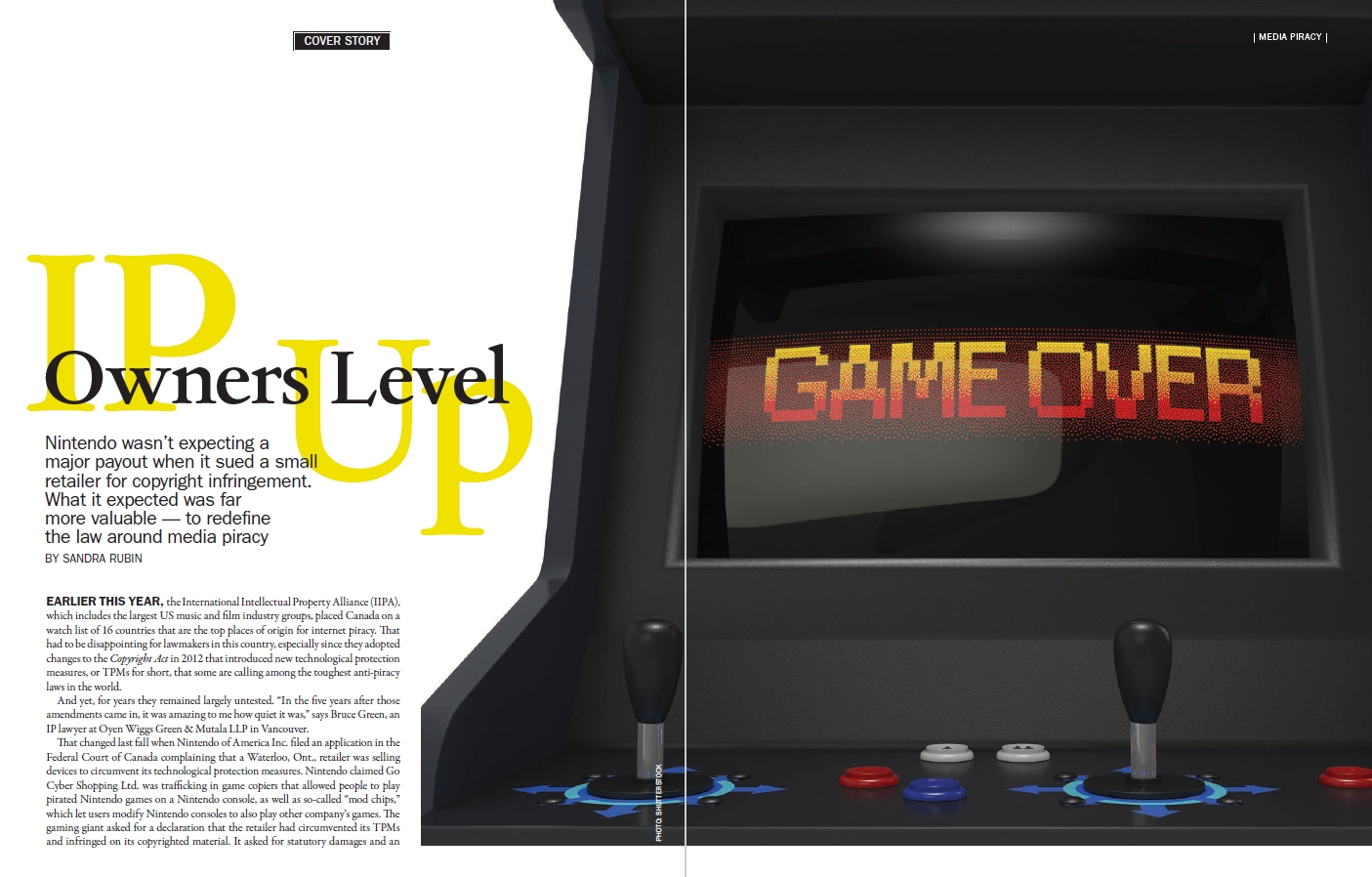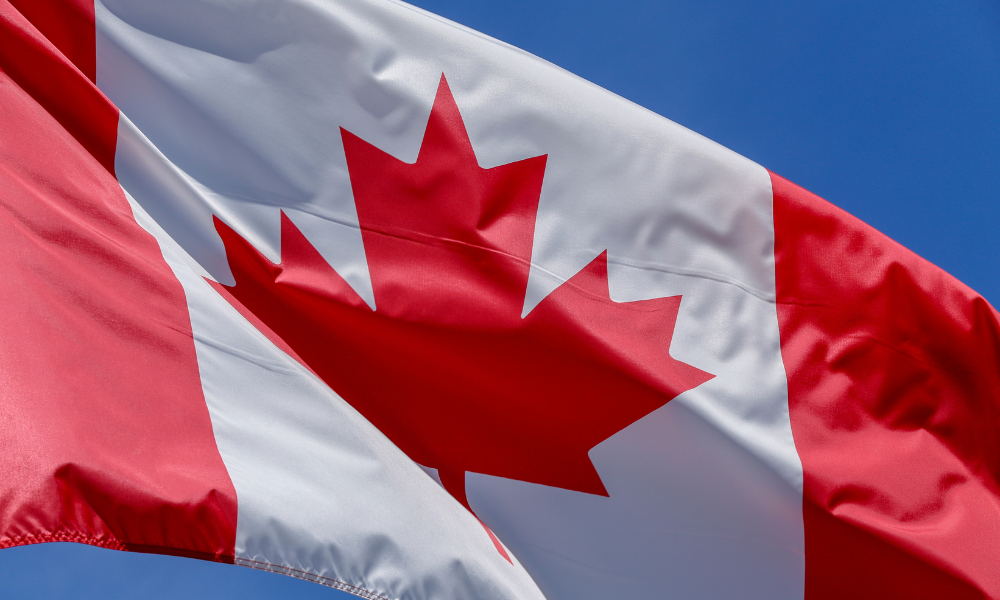 EARLIER THIS YEAR, the International Intellectual Property Alliance (IIPA), which includes the largest US music and film industry groups, placed Canada on a watch list of 16 countries that are the top places of origin for internet piracy. That had to be disappointing for lawmakers in this country, especially since they adopted changes to the Copyright Act in 2012 that introduced new technological protection measures, or TPMs for short, that some are calling among the toughest anti-piracy laws in the world.
EARLIER THIS YEAR, the International Intellectual Property Alliance (IIPA), which includes the largest US music and film industry groups, placed Canada on a watch list of 16 countries that are the top places of origin for internet piracy. That had to be disappointing for lawmakers in this country, especially since they adopted changes to the Copyright Act in 2012 that introduced new technological protection measures, or TPMs for short, that some are calling among the toughest anti-piracy laws in the world.And yet, for years they remained largely untested. “In the five years after those amendments came in, it was amazing to me how quiet it was,” says Bruce Green, an IP lawyer at Oyen Wiggs Green & Mutala LLP in Vancouver.
That changed last fall when Nintendo of America Inc. filed an application in the Federal Court of Canada complaining that a Waterloo, Ont., retailer was selling devices to circumvent its technological protection measures. Nintendo claimed Go Cyber Shopping Ltd. was trafficking in game copiers that allowed people to play pirated Nintendo games on a Nintendo console, as well as so-called “mod chips,” which let users modify Nintendo consoles to also play other company’s games. The gaming giant asked for a declaration that the retailer had circumvented its TPMs and infringed on its copyrighted material. It asked for statutory damages and an injunction preventing the retailer from continuing to do so.
Less than two weeks after Canada was criticized in the IIPA report, Justice Colin Campbell released his ruling in Nintendo v. King (2017 FC 246), wherein he found the Ontario retailer guilty of selling illegal circumvention software and of copyright infringement.
It’s a decision that’s making legal experts stand up and take notice. Firing a shot across the bow at would-be pirates, the decision holds that proving actual infringement of copyright is not necessary for an award of statutory damages for TPM circumvention. It also takes the harshest possible view on calculating statutory damages, awarding Nintendo $12.76 million.
Many pirates are small-timers who operate online stores out of their basements. These people probably never think about the high cost of paying to defend themselves, nor the possibility of a court award taking away everything they have if they get caught — but they should, says Jennifer Davidson, an associate at Deeth Williams Wall LLP. “This was a warning.”
As a precedential decision, the reasons — written by Nintendo’s counsel at the court’s request — address some novel and important issues in Canadian copyright law including the scope of the anti-circumvention rules, what constitutes a technological protection measure, and the way damages will be calculated for wronged copyright owners.
While the decision answers several questions, it also raises a few. For instance, what can be considered “technology” in a TPM, and can we expect more instances in the realm of piracy and new technology in which the reasons are written by the applicant company itself? (Smart & Biggar, which acted for Nintendo, declined an interview request.)
By the time Nintendo was over, the message on TPMs couldn’t have been clearer: in a fast-changing digital universe, going forward, pirates using Canada as a base can expect the country’s courts to apply the new anti-piracy laws to the maximum.

SIDEBAR: The Dominant Argument
Nintendo's claims were undefended, but future claims may be more balanced
NINTENDO CENTRED on the technological protection measures the company uses to keep to digital pirates out of its copyrighted video games on its various consoles: the DS, 3DS and Wii. TPMs are also used by Sony, Microsoft, Apple and a broad array of software makers, as well corporations that use pay walls or require licences to access online material. “They’re designed to keep pirates out of the digital vault,” says Davidson — that means people who sell or share pirated software, video games, films, songs, movies or e-books online.
Do TPMs always work, especially with each generation of kids getting more technologically literate? No, they do not. The question is what happens when pirates are caught, and thanks to Nintendo, Canada finally has some answers.
The case didn’t really got going until October with an application hearing before Justice Campbell. In its statement of claim, Nintendo argued that Go Cyber Shopping., which had a store and a website, was breaking the law by allowing people to use game copiers to play illegally downloaded copies of its games on its handheld DS and 3DS consoles. Go Cyber also carried on business at its store and online as Modchip Central Ltd., selling the mod chips and kits to play pirated games on the company’s Wii home video game console. Go Cyber even offered mod-chip installation services. Jeramie Douglas King is listed as Go Cyber’s sole officer and director.
It’s not as though the retailer was discreet about its activities, the decision noted. In fact, it actively promoted its products through social media. It issued product announcements, engaged in discussions on social media regarding the status of new product shipments, and it took pre-orders for next-generation devices. The company openly used the term “Game Copiers” to refer to such devices.
Nintendo was asking for statutory damages and an injunction. It argued that Go Cyber advertised and sold 10 models of game copiers, mod chips, kits and tools specifically designed to circumvent the TPMs installed on its three gaming consoles.
The way a game copier works is, you put an illegally downloaded copy of a Nintendo game on to a memory stick, put the stick into the game copier and insert the copier into the Nintendo console. The Game Copier mimics the proprietary game cartridge by using its header data — code that shows the Nintendo logo and also provides the code, data, encryption and scrambling technologies that form the technological protections that tell the console this is a legitimate Nintendo game.
The fake cartridge also mimics the specific cartridge shape Nintendo designed to try to keep digital pirates at bay. Nintendo designed the shape of the cartridge and the arrangement of the electrical pins to fit specifically into a corresponding slot on each of its consoles, the decision says: “Together they operate much like a lock and key.”
The ruling that that was handed down in March agreed with Nintendo on all counts. In part of the reasons that has created buzz in the IP world, the court held that the cartridge’s shape was part of Nintendo’s technological protection measures, noting: “A burglar who uses an illicitly copied key to avoid or bypass a lock to access a house is no less of a burglar than one who uses a lock pick.”
Catherine Lovrics, a partner at Bereskin & Parr LLP in Toronto, an IP boutique, says the finding that the shape of a device or cartridge may constitute a TPM is enormously significant, and moves intellectual properly law from the world of ideas into the physical world. “To put it into plain language I don’t know that shape is necessarily technological, but the court accepted that it was.” She calls it “a broad interpretation of a technological protection measure” and “a significant one” at that.
Scott Miller of MBM Intellectual Property Law LLP in Ottawa calls it “huge.” MBM is the counsel of record for Go Cyber Shopping and Jeramie King. Miller, who chairs the firm’s litigation group, had occasional communication with opposing counsel but was not otherwise active on the file. He spoke only about the implications of the court’s finding, not the case itself.
He says that, while the finding regarding shape is designed to ward off pirates, it may also have the effect of preventing standardization of things like phone plugs. “If you allow that, you prevent the standardization of industry. Think of it from the consumer’s point of view, on something like a USB plug. Does it mean Dell is going to have its own interface, and Sony another, and Apple another? What’s that going to do? We have standardization for consumer accessibility. Is this finding going to potentially open the door to undoing that?”
THE COURT RAN OUT OF TIME after hearing Nintendo’s first round of arguments in October, so the hearing was adjourned until November, at which point the defendants would have a chance to reply. But on the continuation date, the lawyer for King and Go Cyber Shopping advised the court that Nintendo had reached a settlement with King, as the individual respondent, on all issues including liability and quantum of damages.
Nintendo’s counsel said, regardless of the settlement with King, it planned to press on with its case against Go Cyber as the corporate respondent. Go Cyber’s lawyer advised the court that counsel would not be attending oral arguments in defence of the continuing claim, but would rely solely on written representations first filed in response to the application.
In that early written response, part of Go Cyber and King’s defence was that they were offering the devices to help customers “homebrew” games on their Nintendo systems. Miller explains that, in general, if you have a console and want to design or “homebrew” your own games, a gaming company may not have any problem with that. “It’s essentially the ability to make games for a console that the company itself has not made.”
But in its reasons, the Federal Court ruling shot that defence down, saying the only mention of “homebrew” on Go Cyber’s website was that it had “no homebrew at the moment,” and the company also failed to present any evidence that any users actually did use their services or devices for that specific purpose.
Despite Go Cyber’s decision not to participate in the continuing proceedings, Nintendo aggressively argued its claims. It tendered extensive affidavit evidence from three expert witnesses. Go Cyber filed no evidence and did not cross-examine any of the witnesses, instead arguing — “unsupported by evidence,” as the decision notes — that, at the end of the day, Nintendo had failed to prove its case.
Justice Campbell was clearly not impressed with Go Cyber’s decision not to present or respond to any evidence against it. While the burden of proof always falls on the plaintiff, and a defendant can elect not to submit evidence and later argue that the claim on a balance of probability has not been proven, Justice Campbell noted in his decision that “an adverse inference may be drawn from a party’s failure to lead evidence that was in its power to produce.” Ultimately, Justice Campbell concluded that Nintendo’s evidence stood “uncontradicted and unchallenged, and in my opinion, is unassailable in fully proving the claims made.”
The judge also explained his rationale for using Nintendo’s counsel to write the reasons. He noted that Nintendo had an interest in developing the law around the new technical protection measures: their circumvention, statutory damages, and enforcement measures, to the benefit of the industry both in Canada and globally. Given the high precedential value of this expected outcome, and “at my request,” he says, Nintendo’s lawyers agreed to supply a final consolidated written argument stating the terms that the company would want to form the substance of the final determination of the litigation.
Nintendo’s consolidated written argument was filed and served on Go Cyber’s lawyers to allow for a reply. One was provided. In a letter just before Christmas, the court received a note that said: “kindly be advised that the Respondent will not be filing additional representations …”
Justice Campbell wrote that in order to fairly acknowledge the “precise, clear, well supported, and effectively uncontested final argument prepared by Nintendo’s counsel, with which I fully agree,” Nintendo was entitled to have its final argument used as his reasons for decision in the litigation. (Providing reasons in support of a decision where one side essentially sits out a trial can be challenging for a judge, who is expected to be the equivalent of a layman on the intricacies of the subject, as he or she hears arguments from just one side.)
He ordered Go Cyber to pay Nintendo $12.76 million for circumvention of technological protection measures and copyright infringement under the Copyright Act — it’s that damage calculation that also has many in the IP community talking.
THERE’S NO CLEAR wording in the Copyright Act explaining how statutory damages for the circumvention of TPMs should be calculated. Theoretically, it could be a matter of taking the statutory amount, which is between $500 and $20,000 per violation, and multiplying it by the number of TPMs the guilty party circumvented, which in this case would have been the three: one for Nintendo’s DS, one for its 3DS, and one for its Wii consoles. Or the court could choose to multiply the amount by the number of copyrighted works that could potentially be accessed as a result of the circumvention — in this case 585 games.
The court decided on the latter route of 585 games and assessed the maximum allowable damages of $20,000 each. “What the court said is, you don’t actually have to have used the infringing work, it’s enough if you had access to it,” says Miller of MBM. “That is huge because what they’re saying is, if you have 1,000 games, we’re going to give you damages for 1,000 games, not just for the code. The implication of the decision might be greater than standard straight copyright infringement because you don’t have to prove there was infringement of the underlying work, only that there was access to the underlying work. That’s massive.”
The court ordered Go Cyber to pay $11.7 million in statutory damages for circumventing the TPMs, $60,000 for copyright violations of the header data, and $1 million in punitive damages.
Kevin Sartorio, an IP litigator who heads the IP department at Gowling WLG (Canada) LLP in Toronto, says it is likely that Nintendo argued for the more punitive route for the precedential and deterrence value. He says the company clearly wanted to deliver a message to pirates, or prospective pirates. “They wanted to say that, if you’re going to traffic in the technology that allows other people to access our portfolio of titles, then you’re going to expose yourself to the risk the court is going to assess statutory damages based on what you provided them access to — not just what you’re physically handing over at the time of the transfer.”
He believes the decision and damage award sends a signal internationally that, when it comes to internet piracy, Canada “is trending in the right direction.”
In terms of the precedent, the fact that the case was not fully defended may prove to be its Achilles’ heel, he and other say. “The next time a case with a similar fact pattern gets before the Federal Court, but there is a defendant with more successful access to legal resources who wishes to put forward more robust arguments, this case is not going to be used by a subsequent judge to say, ‘The issue’s already been decided,’” Sartorio says.
“A subsequent judge will look to the Nintendo case and they will be aware that it doesn’t appear to have been robustly contested, so it may be that some of the more sophisticated legal arguments including as to whether the shaping of your discs and how they fit into your console is a technological protection measure … may possibly result in a modestly revised opinion.”
But Sartorio also makes it clear that Justice Campbell and his approach, which he characterizes as being very much in support of IP owners, “is something I think other judges would take as a starting point, because it is very clear that, in its 2012 amendments, Parliament intended these changes in the Act to come in as very broad enforcement mechanisms.” He doesn’t believe subsequent judges are going to be looking for ways to eviscerate Justice Campbell’s ruling. “I don’t think the court is likely to be sympathetic and bend over backwards to look for creative ways to narrow the reading.”
Parliament is preparing to conduct its statutorily mandated five-year review of the law later this year, and those involved will almost certainly be looking at Nintendo, says Jennifer Davidson of Deeth Williams Wall. “This decision is the only opportunity they have to look at how the court will interpret the Act — unless something else comes up. It’s a rather wide interpretation, so I think Parliament will look at whether that was their intent when they put forth this provision.”
DESPITE A RULING overwhelmingly in its favour, Nintendo is unlikely to ever see that $12.76 million award — not from a single-man operation in Waterloo, Ont.
A private settlement was reached, and the terms were not disclosed — but the personal settlement Nintendo reached with King is public and suggests he is not swimming in money. An order issued March 23 signed by Justice Richard Southcott notes King had been ordered three weeks earlier to pay Nintendo $70,000, of which $45,000 “remains due and unpaid.” He ordered the amount be secured against King’s Waterloo condominium.
Catherine Lovrics of Bereskin & Parr says that, when you put the Go Cyber damage award and the personal settlement order side by side, “reading between the lines, it looks to me like they settled with the personal defendant, but the case went forward against the corporate defendant not really expecting to collect. The quantum of damages against the defendant is staggering from a precedential perspective, and is significant — especially in Canada, where we don’t see these huge, huge awards. But in terms of whether or not Nintendo is actually planning on collecting against the corporate defendant, the answer is likely no. I believe that the case went forward for the sake of determining the law.”
Sandra Rubin is a Toronto-based writer and strategic consultant.




